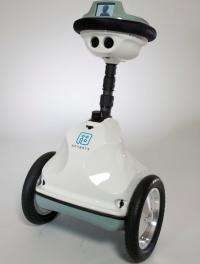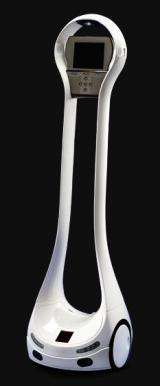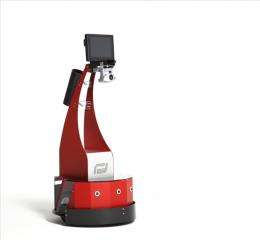New robots give absent workers presence in office

Late one July night, Mountain View, Calif., Fire Captain Verne Chestnut and his crew were checking out a fire alarm at an office building near Highway 237 when he saw movement inside. Worried that someone might be trapped, he took a closer look.
What he saw was not a person but a robot, and it was waiting at the front door, as if to greet them. After the fire crew got inside, the robot, which looks like a Segway scooter with a head instead of handlebars, followed them as they inspected the building. And after they finally succeeded in shutting off the alarm, it spoke to them.
"It was just like, 'You're kidding!' " said Chestnut. "It was definitely different being met by a robot."
Chestnut quickly learned that the voice of the robot belonged to Trevor Blackwell, the CEO of Anybots, the robot-making company whose alarm had sounded. Blackwell, on vacation in Hawaii, was controlling the robot over the Internet. And if he's right, robots like the ones his company makes are about to become commonplace.
Anybots' QB model is just one of a group of new remote-controlled robots now hitting the market. Employing communications technologies similar to Skype and robotic technologies akin to those found in robots used to explore Mars or help defuse bombs in Iraq, the new robots cost far less than their predecessors and are designed for more ordinary uses.
Blackwell, who founded Anybots nine years ago after leaving Yahoo, says the $15,000 QB can inspect warehouses or factories remotely or provide tech support. Security firms are also likely to be interested, said Jackie Fenn, an analyst who covers emerging trends at Gartner, a technology research firm. If security guards see something suspicious on a video camera, they could send in a robot to get a closer view, rather than having to go out and inspect it themselves.
Anybots' competitors include VGO, a New Hampshire-based company that is developing two-wheeled robot similar to QB that has a video screen instead of a "head." Santa Monica, Calif.-based RoboDynamics, meanwhile, has for two years been selling a robot called TiLR that has a much more industrial look but is similarly being targeted for use by remote employees and costs just $10,000. And Santa Barbara, Calif.-based InTouch Health is building robots for use in hospitals and other health care settings by remotely located physicians.

The declining prices for telepresence robots will encourage experimentation among companies and entrepreneurs, who will find new uses for them, say analysts.
"These robots will have a network effect," said Hyoun Park, an analyst at the Aberdeen Group, a technology research firm. "The more robots there are, the easier it will be to work remotely in ways we haven't thought about before."
QB and similar robots could eventually be used to let consumers preview houses or hotels from afar, to allow disabled people to virtually visit tourist destinations, or to help fashion experts, from the comfort of their homes, give sartorial consultations to consumers at clothing stores across the country. Already, QB is undergoing testing by NASA and Wolfram Research founder Stephen Wolfram.
For now, Anybots is pitching the QB to companies with remote workers. Currently executives of those companies often meet with remote workers via video or teleconferences, or by having them flying in to the main office. But Blackwell argues that QB is a better solution because managers don't have to coordinate schedules so everyone is in the same place at the same time. Also, it allows users to wander around and have the more informal conversations they might have if they were actually in the office.
Blackwell notes that buying a QB can be cheaper than flying remote workers to and from the main office: "A couple trips to Asia can easily cost you more than the cost of the robot, not even counting the waste of time in the air."
Remotely controlled by the arrows on the keyboard of an Internet-connected computer, QB moves around on two wheels. Via a built-in Wi-Fi antenna, it relays video of its surroundings back to its user's Web browser from its video camera eye and allows users to talk with colleagues through a built-in microphone and speaker. Users can point to notes on walls and other objects with the laser pointer built into the QB's other eye. They can display their name or picture on the screen located in the center of what looks to be the QB's sea-green tiara.
While working from home, Blackwell and other employees frequently connect to a QB to check in with Anybots' employees in the office. The company also has also hired a "virtual" receptionist.
All calls to Anybots are directed to Suzanne Brocato's house in Martinez, Calif., some 60 miles from the company's headquarters. Brocato fires up one of the QBs from home whenever she needs to greet a scheduled guest at the office or to virtually attend a company meeting.
"Everyone's so happy to greet the robot," Brocato said.
For the near term at least, the range of applications for QB and similar rivals will be limited by their lack of arms to manipulate things in their environments. Arms are a challenge because they make the robots more expensive, more difficult to use and less stable, analysts say.
QB has some other shortcomings as well. Users can't tilt its head up or down, so it can be difficult to see something that's not at the robot's eye level. Its "neck" can be raised or lowered to a different height, but that can't be done remotely by the operator. And QB has only one eye-level camera and can't move its head side to side, so its peripheral vision is narrow.

Those limitations haven't dimmed the excitement of tester Wolfram, who created the scientific computer program Mathematica and whose company last year launched the Wolfram|Alpha search engine. Slated to give a talk near his company's headquarters in Illinois at an event offering a 50-year retrospective on computing, Wolfram had a QB stand in for him.
Wolfram lives in Boston and for years has used video conferencing to communicate with workers at his company's headquarters and in its offices around the world.
"I'll get one of these," he said of the QB. "I always threatened to have robotic technology to wander around various parts of the company."
(c) 2010, San Jose Mercury News (San Jose, Calif.).
Distributed by McClatchy-Tribune Information Services.


















